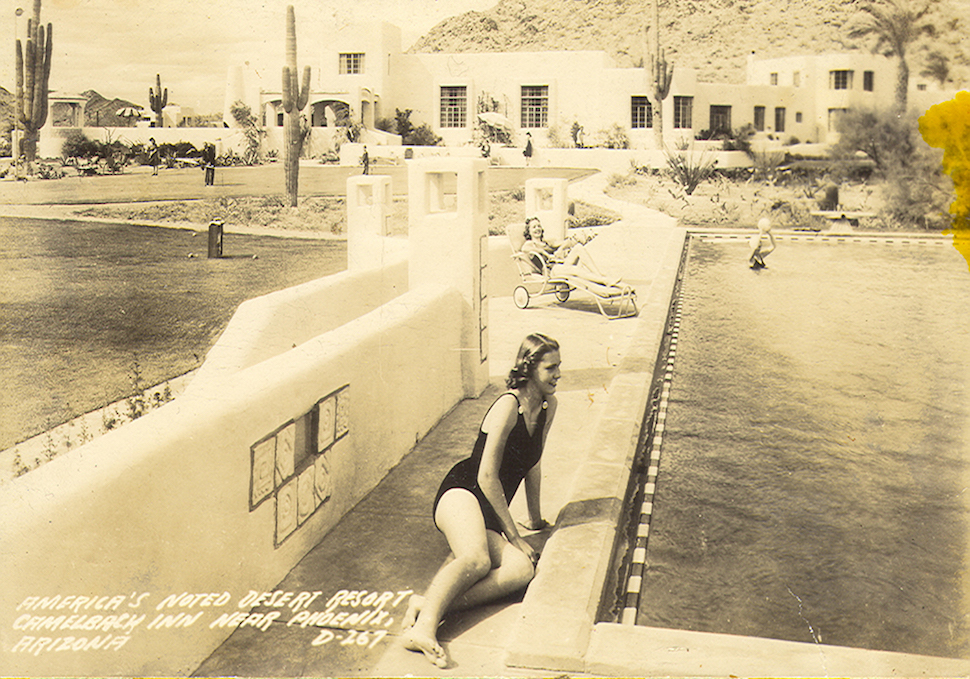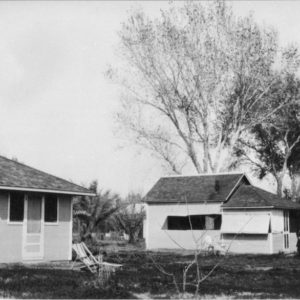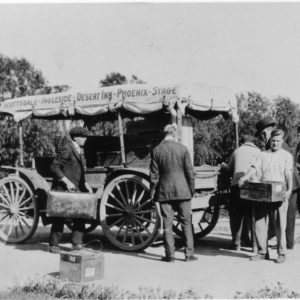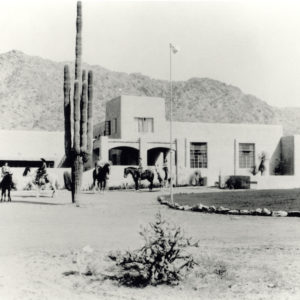
Scottsdale, Arizona has offered an ever-evolving menu of spa treatments, wellness opportunities, and ways to chill out for decades. Celebrities, residents, and visitors have discovered that Scottsdale is the place to relax, rejuvenate, reduce, and reclaim health and wellbeing. The warm, dry, sunny climate and year-round outdoor recreational opportunities are Scottsdale’s perennial health and wellness drawing card; today’s resorts build on those natural assets to create Scottsdale as a spa haven.

Cottages at the Graves Guest Ranch, circa 1910. Photo courtesy Scottsdale Historical Society.
The earliest settlers in the area we now know as Scottsdale (founded by Chaplain/Major Winfield Scott in 1888) knew the restorative powers of the warm, dry climate. They also consulted with their neighbors, the Salt River Pima-Maricopa Indian Community, for natural remedies and treatments such as for arthritis. Desert plants, like aloe and jojoba, were recognized as beneficial for treatments, and the year-round good weather also promoted outdoor exercise, swimming (mostly in irrigation ditches in the early years; later in resort pools).
In the early 1900s, doctors in the Midwest and East Coast often sent patients with lung problems and arthritis to the Arizona desert to recover; many of those patients ended up in the tiny farming village of Scottsdale. Winfield Scott himself recognized the healthful opportunities of Scottsdale, and let “friends and friends of friends” winter in tent-cabins on his property to rejuvenate.
People began wintering at rustic “health camps” in Scottsdale in the early 1910s, nearly a decade before Scottsdale had electricity. Graves Guest Ranch, on the northwest corner of Scottsdale and Indian School roads, was Scottsdale’s first health camp, operated from the early 1900s through the 1950s. Guests—sleeping in tent cabins—benefitted mostly from the climate (no spa “treatments” as we know them today); home-cooked meals of local farm-produced fruit, citrus, vegetables, dairy, and meat; and gentle outdoor activities that included croquet, riding horses, and hiking to picnics.
People began wintering at rustic “health camps” in Scottsdale in the early 1910s, nearly a decade before Scottsdale had electricity.

The Ingleside Inn offered guests locally grown produce in its dining room and on catered picnics at Camelback Mountain. Photo courtesy Scottsdale Historical Society
Ingleside Inn, Scottsdale’s first “luxury” resort (near the site of today’s Arizona Country Club) opened for winter seasonal stays in 1909/10. It specifically did not take in “sick” people but advertised Scottsdale’s winter climate and locally produced fresh menu items as its key attributes. Guests exercised by playing golf on Ingleside’s course, horseback riding, and picnics catered inside Echo Canyon on Camelback Mountain.
During World War II, local inns became “rest and recuperation” havens for members of the military, especially those recovering from combat and war wounds. Future president John F. Kennedy was among those enjoying R&R at the Camelback Inn. Members of the armed forces serving in Vietnam were also treated to R&R visits at Camelback Inn.
Maine Chance & Mamie
Elizabeth Arden opened Maine Chance, a ladies-only luxurious health spa/resort on the southeast base of Camelback Mountain circa 1947. It pampered its guests from November 1 to early April.
According to an article about Maine Chance in the March 12, 1950 Arizona Republic, “To all it gives the rudiments of a new life, a refreshed outlook, an insurance for happy existence. The usual stay is two weeks. Always it begins with a thorough checkup with the Chance physician. Breakfast is served in bed, luncheon comes at 1 o’clock in a sun-kissed patio where gay umbrellas break Old Sol’s glare, dinner is served at 7 p.m. Most daily activity is centered around the elongated swimming pool shaded by Italian-type loggia terraces. Guests arrived at the pol at 9 a.m. where they begin their individual corrective exercises. They are measured and weighed. Then they take either a steam bath in the Howard cabinet or an Ardena bath where they are rubbed with melted paraffin wax, wrapped in wax paper and sheets for a half-hour. Often the plump woman will lose a pound per treatment—or, if she has arthritis such a treatment offers respite from pain . . . ” Massages, swims, scalp and nail treatments, and facials were a daily ritual, as well as a post-luncheon nap. Maine Chance served the Scottsdale area’s first spa cuisine. The March 1950 Arizona Republic article stated “salt, pepper, sugar, and butter never find their way into any dish.” No alcohol was served; most were on a 900-calorie a day diet of “pure food.”
First Lady Mamie Eisenhower (often accompanied by her sister), Mrs. Henry (Christina) Ford, columnist Sylvia Porter, D.C. hostess Perle Mesta, actresses Ava Gardner, Rosalind Russell, and Ethel Barrymore, Ambassador/playwright Clare Boothe Luce, Mrs. John Foster Dulles, and author Edna Ferber were among the celebrity guests at Maine Chance, often coming as personal friends of Elizabeth Arden. Men were prohibited on the grounds; however, President Eisenhower was granted a dispensation to have dinner with his wife in her cottage during a February 1958 visit.
Maine Chance clientele, here for the spa, also loved Scottsdale in the late 1940s through the 1960s because it was such an eclectic arts & crafts and fashion center, with jewelry, leather and silk-screen fashion artists like Lloyd Kiva, Charles Loloma, Christina Rae, Jerome of Scottsdale, Leona Caldwell, etc. having shops along Fifth Avenue and throughout the downtown Scottsdale area.
A Health & Fitness Hotspot

The front entrance of Camelback Inn back in the day.
It has been said that Scottsdale became a spa hideaway for Hollywood because it was off the beaten path . . . Palm Springs was too close, and those seeking to get away from it all might run into too many people they knew in SoCal. Scottsdale men could tend to their appearances at barber shops on Main Street as far back as the 1920s; beauty shops, or parlors, didn’t make an appearance until after World War II, when a population and tourism boom created new demand. Countess Elena operated a salon at the Safari Hotel.
Perhaps Scottsdale’s first “day spa” was the Western Health Salon on First Avenue. Operated by Shirley and Charlotte Brown, it offered steam baths, massages, rowing machines, colonics, and belt vibrators for spot reducing. A 1950 ad in the Scottsdale Progress said “We are trained in physio-therapy techniques and can take your doctor’s order either for reducing or follow his prescription for treatments. We have treated with success sinus headaches, lumbago, neuritis, sciatica, sacro iliac, cramps, poor feet, poor elimination, and associated ailments.” The site morphed into the Pima Athletic Club, a men-only gym. A 1964 article in The Arizonian quoted a club board member describing one of the club’s attributes: “its attraction to the retired man of 55 or more, looking for a spot to rest and relax while his wife ‘shops or visits with the girls.'”
During the mid-1960s, developers of Villa Monterey Casita Colony advertised that residents “enjoy their own resort and health spa,” setting the stage for future master planned communities to offer health clubs, spas, gyms, fitness centers, walking paths, golf courses, tennis courts, and other means for exercise and wellness pursuits.
Countess Elena operated a salon, spa, and charm school in downtown Scottsdale in the mid-1960s. She was a judge of the Miss Universe contest.
Realizing that youth and residents of modest means would also like to pursue fitness regimens, members of the 1964 Scottsdale Town Enrichment Program encouraged the city to establish a system of neighborhood and city parks. The new first park to open was El Dorado Park in 1967; it included a swimming pool and recreation center.
In 1974, the City of Scottsdale opened Club SAR (Social, Athletic, Recreational) to provide an outlet for young people to learn responsibility through boxing. On opening night, 1,200 attended an exhibition boxing match. In 1984, the city moved Club SAR to facilities at Indian School Park and reopened it as a full-fledged fitness center.
The Luxury Resort Boom
Today’s spas offer yoga and meditation techniques and can trace their local origins to the Franciscan Renewal Center, a former guest ranch taken over in 1950 by members of the Franciscan order and offering restful, meditative retreats.
Most spas have Jacuzzis; that popular therapeutic bath has a local tie, too. Ken Jacuzzi, inspiration for the invention of the Jacuzzi whirlpool bath by his father and uncle, lived in the Scottsdale area for many years until his death in January 2017. Read about his inspiring life as a business leader and activist for people with disabilities in Jacuzzi: A Father’s Invention to Ease a Son’s Pain, by Ken Jacuzzi and Diane Holloway.
As Scottsdale’s luxury resort boom began in the 1970s and continued through the 2000s, having a spa was as important as having beds in rooms.Today, there are nearly 50 RESORT or day spas in the Scottsdale area, complemented by a host of fitness centers, gyms, city recreation centers, fitness classes, and innumerable salons. Even area hospitals have spas—but the spa and wellness phenomenon started here quite modestly over a century ago.
Joan Fudala
Joan Fudala is a Scottsdale community historian, consultant, and history columnist for local publications. She is the author of eight books, including Historic Scottsdale: A Life from the Land. Prior to her 22-year career as a community historian, Joan was a public relations executive, including positions with the Scottsdale Chamber of Commerce/Convention & Visitors Bureau, two regional airlines, and as a U.S. Air Force public affairs officer. It was her assignment at Luke AFB near Phoenix in the late 1970s that inspired her to return to live, work, and enjoy life in Scottsdale. The recipient of numerous awards, Joan received the 2014 Scottsdale Public Library Spirit of Literacy and 2021 Vision Awards, 2020 Arizona Governor’s Heritage Preservation Award, and was inducted into the Scottsdale History Hall of Fame in 2016.